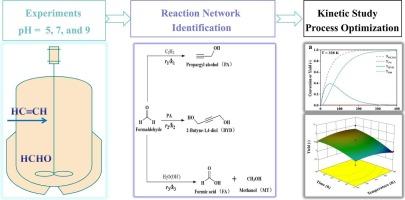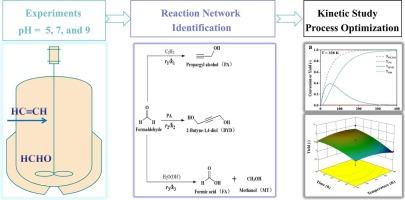浆床反应器合成丁-2-炔-1,4-二醇:机理、动力学及工艺优化
IF 4.3
2区 工程技术
Q2 ENGINEERING, CHEMICAL
引用次数: 0
摘要
本研究在定制的准工业搅拌浆床反应器中,通过乙醛偶联反应合成了-2-炔-1,4-二醇。采用工业级催化剂,我们系统地研究了pH在5 ~ 9范围内对反应机理的影响,并在328 ~ 358 K范围内建立了半批操作下的温度调节动力学曲线。然后利用时间分辨产物分析确定了具体的反应网络,并通过动力学建模揭示了各个步骤的反应活化能。模型验证结果表明,该动力学模型是可靠的,并用于研究反应时间和温度对丁-2-炔-1,4-二醇产率的影响。最后,在模型预测的基础上,采用响应面法对反应条件进行优化,并通过实验对优化后的操作参数进行了验证。该综合分析框架将机理见解与反应器规模工程联系起来,为ph -温度耦合控制和放大驱动的流体动力设计提供实用指导。本文章由计算机程序翻译,如有差异,请以英文原文为准。


Synthesis of But-2-yne-1,4-diol in a slurry bed reactor: Mechanisms, kinetics and process optimization
In this study, but-2-yne-1,4-diol was synthesized via acetylenic-aldehyde coupling reaction in a custom-designed quasi-industrial stirred slurry bed reactor. Employing industrial-grade catalysts, we systematically examined the influences of pH ranging from 5 to 9 on reaction mechanisms and established temperature-modulated kinetic profiles within 328–358 K under semi-batch operations. We then identified the specific reaction network using time-resolved product analysis, and revealed the reaction activation energies of individual steps through kinetic modeling. The model validation results illustrated that the kinetic model was reliable, and subsequently used to study the effects of reaction time and temperature on the yield of but-2-yne-1,4-diol. Finally, based on model predictions, response surface methodology was employed to optimize the reaction conditions, and the optimized operational parameters were successfully validated by experiments. This integrated analysis framework connects mechanistic insights with reactor-scale engineering, providing practical guidance for pH-temperature coupled control and scale-up driven hydrodynamic design.
求助全文
通过发布文献求助,成功后即可免费获取论文全文。
去求助
来源期刊

Chemical Engineering Science
工程技术-工程:化工
CiteScore
7.50
自引率
8.50%
发文量
1025
审稿时长
50 days
期刊介绍:
Chemical engineering enables the transformation of natural resources and energy into useful products for society. It draws on and applies natural sciences, mathematics and economics, and has developed fundamental engineering science that underpins the discipline.
Chemical Engineering Science (CES) has been publishing papers on the fundamentals of chemical engineering since 1951. CES is the platform where the most significant advances in the discipline have ever since been published. Chemical Engineering Science has accompanied and sustained chemical engineering through its development into the vibrant and broad scientific discipline it is today.
 求助内容:
求助内容: 应助结果提醒方式:
应助结果提醒方式:


